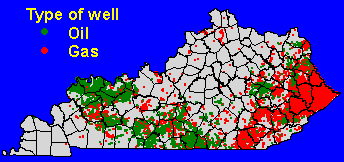| GMHR |
 |
|
Oil and natural gas occur throughout much of western, south-central, and eastern Kentucky. At the surface, early explorers and settlers found many seeps, evidenced by place names such as Burning Springs, Oil Springs, and Oil Valley. In the subsurface, oil and gas are found where porosity, permeability, traps, and hydrocarbon sources combine to form a reservoir. Drilled wells penetrate the reservoirs to produce the hydrocarbons. Primary production recovers oil or gas that flows or can be pumped to the surface. Naturally occurring brines, remnant waters from the oceans in which the reservoir rocks were deposited, may be produced in association with oil. During primary production, an average of only one-third of the oil in place is produced. After primary oil production, the remaining oil must be recovered by other means. Secondary recovery uses circulated water (and other chemicals or fluids) to displace additional oil and bring it to the surface. |